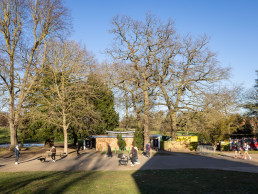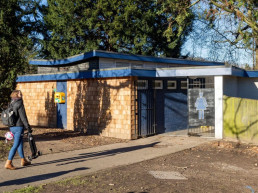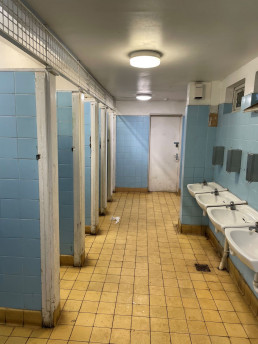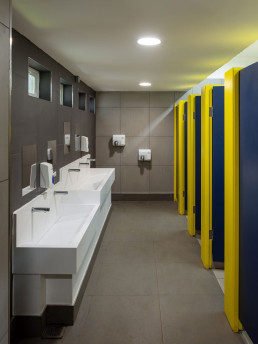Going Public; reviving the Crystal Palace Park loos
Written by
James Krikler
James Krikler is an architect and associate at BoonBrown who has led projects from transformational masterplans and urban regeneration to commercial, healthcare and residential development at all scales, and is immensely proud of this latest work.

What do Palace, Park and Public all have in common?
I wouldn’t want to overstate things, but over the last few months, something remarkable has occurred in a large, green corner of south London. Among the trees and beside some aging maintenance buildings, the sounds of tools and hard-at-work builders provided an unusual backdrop to the usually tranquil park setting. For a while there were temporary loos, mesh fencing, and only tantalising views of emerging fresh paint and cedar shingles. But then, Ladies and Gentlemen, just in time for Christmas, the only public toilets in Crystal Palace Park were finally reopened, having at last been refurbished!
Those more familiar with this part of the world will know that the management of the park has recently changed hands from Bromley council to the newly formed Trust, with its ambitious plans to revitalise all parts of this important and historic amenity. Backed by a board made up of enduring locals and seasoned campaigners, they quickly identified that one of the first undertakings of the Trust should be to sort out the dismal park loos. Indeed, when the public was recently surveyed, this was cited as the number one issue. The existing toilet provision was limited, and frankly, an all-round grim experience.
The truth is that the long-suffering park users had been making do with inadequate ‘inconveniences’ for years, through lack of investment or genuine attention. Not to be too critical of cash-strapped local authorities with many calls upon their budgets. But answering the call of nature is one of the most basic of human needs, and here it had been largely neglected. As the Trust announced at the handover event in September to rapturous applause; with the peak summer activity out of the way, this would be their first priority.


BoonBrown had won the open design competition earlier in the year, with our Brixton based studio happy to get involved in a local, community driven project – one that would be perfect for both our architectural and landscape teams. A challenging budget however, meant tough decisions were needed on priorities, materials and the overall scope of the works. To most people, £100k or so, might sound like a lot of money, however in the world of construction that is easily consumed. Never mind the inevitable added expense of working on an existing building in a relatively poor state of repair.
As architects and contract administrators, we approached half a dozen builders, small and large, and were knocked back or quoted 3x the budget for the privilege. Finally, the challenge was accepted by Thomas Sinden, with their small works division excited by the unusual project and admirably keen to support a community in need. It was quickly realised by all parties that a collaborative approach would be required; negotiating specification, programme and methodology, with client input all the while.
Forging a real partnership, our two firms set about trying to stretch the funds as far as possible. Value engineering was embraced, with canny detailing and materials selections bringing maximum benefit for minimum cost, while an awareness of the harsh environment of public toilets influenced the choices being made. Thus with an eye fixed on cost, the design quality was somehow maintained, albeit with a bit of a squint. The uprated fabric even includes Corian wash troughs (sourced on clearance through a Manchester firm), while large format porcelain tiling in three grey tones, provides a robust, modern aesthetic.


Of the key changes, both the female and male sides have been brought closer to the latest British Standards, with some enlarged cubicles and ambulant accessible facilities. Items are set at different heights to suit all users. Baby change units are relocated to the larger cubicles from the open lobby, which also suit those with small children, pushchairs, luggage and the like. New light fittings are recessed in low ceiling areas and in the unseen higher section, crisp linear fittings give the impression of generous daylight from above. In the Men’s, the hand washing is relocated to the exit route, for a little hygiene encouragement, as well as making for a more pleasant arrival than being faced with open urinals.
Back to wall type loos specified for ease of maintenance, required boxing out to use existing waste connections. Sloped tops add character and limit use for anti-social purposes. Bright white troughs against dark grey tiles accentuate the sense of a sanitary space. Painted timber cappings redefine cubicle walls, following removal of mesh caging above. They offer a vibrant yellow counterpoint to the restrained grey. Doors are in sophisticated ‘Berlin Blue’, also used externally to cover patchy buff masonry and vaguely white timber fascias, for a consistent palette throughout. Coat hooks and mirrors provide unexpected luxury in such an environment.
The WCs are located off one of the main thoroughfares, across from the popular café building; one of the creditable successes of the previous management. This provides the inspiration for the cedar shingles and blue central strip, bringing a sibling character to the facing southern façade. Conveniently it also provides a setting for a new defibrillator, in an appropriately shocking, yellow box.

What will the public make of the changes and how will they stand the test of time? Of course the shingles will grey, damage will occur and graffiti will remain the bane of the park staff. But in the shared space of a public park this is about as good as it gets. And while the debate goes on elsewhere about the limited provision of toilets in the public realm, we have one standard bearer that should be flushed with pride.
Anyone who previously had the misfortune to use the old facilities might shiver at the memory. They will be pleasantly relieved by what has replaced them. There’s a Churchillian quote that comes to mind, given what has been achieved for the public good, and on such relatively modest funding. Something about so much, so many and so few… though let’s not overstate things, it’s only a toilet block in the middle of a park.